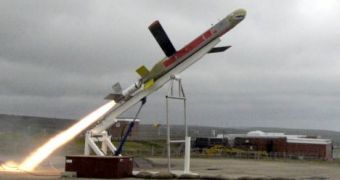A new missile that can follow its target for about 10 hours or 100 miles (161 km) and then strike within a minute with surgical precision is being developed by the Ministry of Defense in order to support the British troops in Afghanistan against Taliban ambushers.
The powerful weapon, officially dubbed Fire Shadow, was developed by the British division of MBDA, Europe's leading missile manufacturer with subsidiaries in France, Britain, Germany and Italy. MBDA had over 10.000 employees and a yearly revenue of 3 billion Euros ($4.06 billion) in 2005. Fire Shadow is a 12-foot (3.66 meter)-long device that will be operated by Royal Artillery's ground or aircraft troops by means of laser. It was first tested in Wales and it is hoped to be operational by 2010. It uses a tiny warhead of 50 pounds (22.7 kilograms), compared with the next smallest bomb used by the Royal Artillery Forces (RAF), which has a 500 pound (227 kilogram)-heavy warhead.
This makes it more maneuverable and its reduced power is meant to decrease the number of possible collateral victims, like civilians or houses. The Royal Army intends to have several of these weapons loitering about, in order to replace human patrols and avoid any useless casualties on its side. Once launched, the weapon will be unable to be retrieved in case it doesn't hit its target, and in this case it will be subjected to a controlled crash after it depletes its fuel. Their operating fashion will hopefully thwart the Talibans' knowledge of the land and repeated ambushes, and compensate the hardships caused by not receiving immediate air support, all of which make British troops' activities impossible.
The Ministry of Defense spent £74million (92.5 million Euros or $125 million) on the project, which also involves UK companies Roxcel, Thales and Qinetiq, as well as other smaller ones. They intend to bring the cost of a single Fire Shadow in the neighborhood of £60,000 (75.000 Euros or $100.000), with a total estimation of the respective missile arsenal of £15million (18.8 million Euros or $25 million). But considering that many of these will be destroyed without them reaching a valid target, one can only ponder on the efficiency of spending such an amount of money, especially when other, more peaceful scientific fields suffer from a severe lack of funding.

 14 DAY TRIAL //
14 DAY TRIAL //